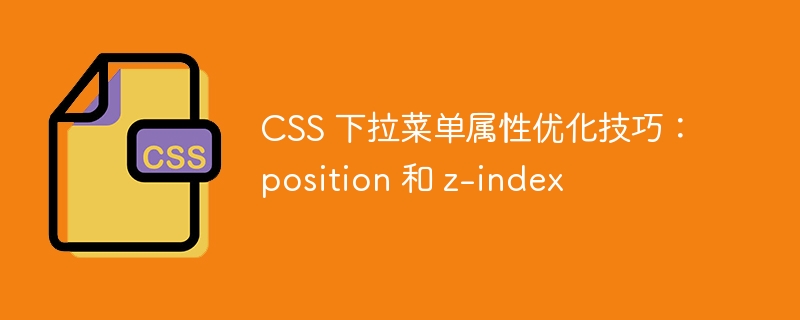

CSS drop-down menu attribute optimization skills: position and z-index
In web design, drop-down menu is one of the common interactive elements. Through the drop-down menu, users can easily select the required options, improving user experience. However, when there are multiple drop-down menus on the page, their positioning and cascading relationship may cause problems. In order to solve these problems, we can optimize the display effect of the drop-down menu by using the position property and z-index property in CSS. This article will introduce you to how to use these two properties to position and cascade drop-down menus, and provide code examples for reference.
The position attribute is used to define how an element is positioned. Commonly used values are static, relative, absolute and fixed. In drop-down menus, we usually use relative or absolute to control its position.
When using relative positioning, you can adjust the position of the drop-down menu by setting the top, bottom, left, and right attributes. For example:
.dropdown-menu {
position: relative;
top: 20px;
left: 10px;
}The above code will cause the drop-down menu to move 20 pixels up and 10 pixels to the left relative to its normal position.
When using absolute positioning, the drop-down menu will be positioned based on its nearest ancestor element. Its position can be adjusted by setting the top, bottom, left, and right properties. For example:
.dropdown-menu {
position: absolute;
top: 100%;
left: 0;
}The above code will cause the drop-down menu to extend 100% of its height downwards relative to the top position of its parent container, aligned left.
By rationally using the position attribute, we can accurately control the position of the drop-down menu to better adapt it to the page layout.
The z-index attribute is used to control the cascading relationship of elements. In drop-down menus, we often face the problem of multiple menus overlapping, resulting in confusing display. By setting the appropriate z-index value, we can change the stacking order of elements to achieve the correct display effect.
When setting the z-index value, you need to pay attention to the following points:
For example, we have two drop-down menus dropdown-menu1 and dropdown-menu2, which are at the same position in the page. To ensure that the display level of dropdown-menu1 is higher than dropdown-menu2 in the viewport, you can set it like this:
.dropdown-menu1 {
position: relative;
z-index: 2;
}
.dropdown-menu2 {
position: relative;
z-index: 1;
}The above code will cause dropdown-menu1 to be displayed above dropdown-menu2.
To sum up, by flexibly using the position attribute and z-index attribute in CSS, we can optimize the position and cascading relationship of the drop-down menu. Properly setting these two attributes can make the drop-down menu displayed on the page more accurate, clear, and easy to use, and improve the user experience.
The above code examples are only for reference and need to be modified accordingly according to the actual situation when used. I hope this article can help you, and I wish you better results in web design!
The above is the detailed content of CSS drop-down menu property optimization tips: position and z-index. For more information, please follow other related articles on the PHP Chinese website!




